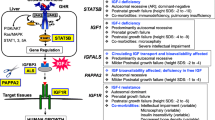Abstract
Purpose
The IGFALS gene encodes the acid-labile subunit (ALS) protein, which regulates circulating IGF-1. Human IGFALS mutations cause growth hormone insensitivity (GHI) associated with ALS, IGF-1 and IGFBP-3 deficiencies and mild to moderate postnatal growth impairment (height SDS −2 to −4). Prenatal growth impairment is not a recognised feature of this disorder, but heterozygous carriers may show an intermediate phenotype.
Methods
We report a family of five subjects, including three children born small for gestational age, who were investigated for IGFALS gene mutations.
Results
The proband, an 8.7 years female with pre- and postnatal growth failure (BW SDS −3.04, Ht SDS −3.86) and biochemical features of GHI, had a homozygous mutation of IGFALS, c.401T>A; p.L134Q. Her 6.1 years brother (BW SDS −2.11, Ht SDS −2.0) had the same homozygous IGFALS mutation. Both parents [adult height SDS −1.76 (father) and −1.82 (mother)] and her 2.7 years sister (BW SDS −2.60, Ht SDS −2.04) were heterozygous for the IGFALS mutation.
Conclusion
Significant phenotypic heterogeneity was observed between family members, in particular varying degrees of prenatal growth retardation were present in the three siblings, which may have contributed to the variation in the postnatal growth phenotype.


Similar content being viewed by others
References
David A, Hwa V, Metherell LA et al (2011) Evidence for a continuum of genetic, phenotypic, and biochemical abnormalities in children with growth hormone insensitivity. Endocr Rev 32:472–497
Domené HM, Bengolea SV, Martinez AS et al (2004) Deficiency of the circulating insulin-like growth factor system associated with inactivation of the acid-labile subunit gene. N Eng J Med 350:570–577
Domené HM, Hwa V, Jasper HG, Rosenfeld RG (2011) Acid-labile subunit (ALS) deficiency. Best Prac Res Clin Endocrinol Metab 25:101–113
Hess O, Khayat M, Hwa V et al (2013) A novel mutation in IGFALS, c.380T>C (p. L127P), associated with short stature, delayed puberty, osteopenia and hyperinsulinaemia in two siblings: insights into the roles of insulin growth factor-1 (IGF1). Clin Endocrinol 79:838–844
Schreiner F, Schoenberger S, Koester B et al (2013) Novel acid-labile subunit (IGFALS) mutation p. T145K (c.434C>A) in a patient with ALS deficiency, normal stature and immunological dysfunction. Horm Res Paediatr 80:424–430
Boisclair YR, Rhoads RP, Ueki I, Wang J, Ooi GT (2001) The acid-labile subunit (ALS) of the 150 kDa IGF-binding protein complex: an important but forgotten component of the circulating IGF system. J Endocrinol 170:63–70
Guler HP, Zapf J, Schmid C, Froesch ER (1989) Insulin-like growth factors I and II in healthy man. Estimations of half-lives and production rates. Acta Endocrinol 121:753–758
Baxter RC (1990) Circulating levels and molecular distribution of the acid-labile (alpha) subunit of the high molecular weight insulin-like growth factor-binding protein complex. J Clin Endocrinol Metab 70:1347–1353
Domené HM, Hwa V, Argente J et al (2009) Human acid-labile subunit deficiency: clinical, endocrine and metabolic consequences. Horm Res 72:129–141
Domené HM, Scaglia PA, Lteif A et al (2007) Phenotypic effects of null and haploinsufficiency of acid-labile subunit in a family with two novel IGFALS gene mutations. J Clin Endocrinol Metab 92:4444–4450
Van Duyvenvoorde HA, Kempers MJE, Twickler ThB et al (2008) Homozygous and heterozygous expression of a novel mutation of the acid-labile subunit. Eur J Endocrinol 159:113–120
Heath KE, Argente J, Barrios V et al (2008) Primary acid-labile subunit deficiency due to recessive IGFALS mutations results in postnatal growth deficit associated with low circulating insulin growth factor (IGF)-I, IGF binding protein-3 levels and hyperinsulinemia. J Clin Endocrinol Metab 98:1616–1624
Fofanova-Gambetti OV, Hwa V, Wit JM et al (2010) Impact of heterozygosity for acid-labile subunit (IGFALS) gene mutations on stature: results from the international acid-labile subunit consortium. J Clin Endocrinol Metab 95:4184–4191
Freeman JV, Cole TJ, Chinn S et al (1995) Cross sectional stature and weight reference curves for the UK, 1990. Arch Dis Child 73:17–24
David A, Rose SJ, Miraki-Moud F et al (2010) Acid-labile subunit deficiency and growth failure: description of two novel cases. Horm Res Paediatr 73:328–334
Ueki I, Ooi GT, Tremblay ML, Hurst KR, Bach LA, Boisclair YR (2000) Inactivation of the acid labile subunit gene in mice results in mild retardation of postnatal growth despite profound disruptions in the circulating insulin-like growth factor system. Proc Natl Acad Sci USA 97:6868–6873
Domené HM, Bengolea SV, Jasper HG, Boisclair YR (2005) Acid-labile subunit deficiency: phenotypic similarities and differences between human and mouse. J Endocrinol Invest 28:43–46
Iñiguez G, González CA, Argandoña F, Kakarieka E, Johnson MC, Cassorla F (2010) Expression and protein content of IGF-1 and IGF-1 receptor in placentas from small, adequate and large for gestational age newborns. Horm Res Paediatr 73:320–327
Lewitt MS, Scott FP, Clarke NM, Baxter RC (1995) Developmental regulation of circulating insulin-like growth factor-binding proteins in normal pregnancies and in pre-eclampsia. Prog Growth Factor Res 6:475–480
Iñiguez G, Argandoña F, Medina P et al (2011) Acid-labile subunit (ALS) gene expression and protein content in human placentas: differences according to birthweight. J Clin Endocrinol Metab 96:187–191
Conflict of interest
The authors have nothing to disclose. There is no actual or potential conflict of interest in relation to this article.
Author information
Authors and Affiliations
Corresponding author
Rights and permissions
About this article
Cite this article
Storr, H.L., Prasad, R., Temple, I.K. et al. Heterogeneity of the growth phenotype and birth size in acid-labile subunit (ALS) deficiency. J Endocrinol Invest 38, 407–412 (2015). https://doi.org/10.1007/s40618-014-0195-1
Received:
Accepted:
Published:
Issue Date:
DOI: https://doi.org/10.1007/s40618-014-0195-1




